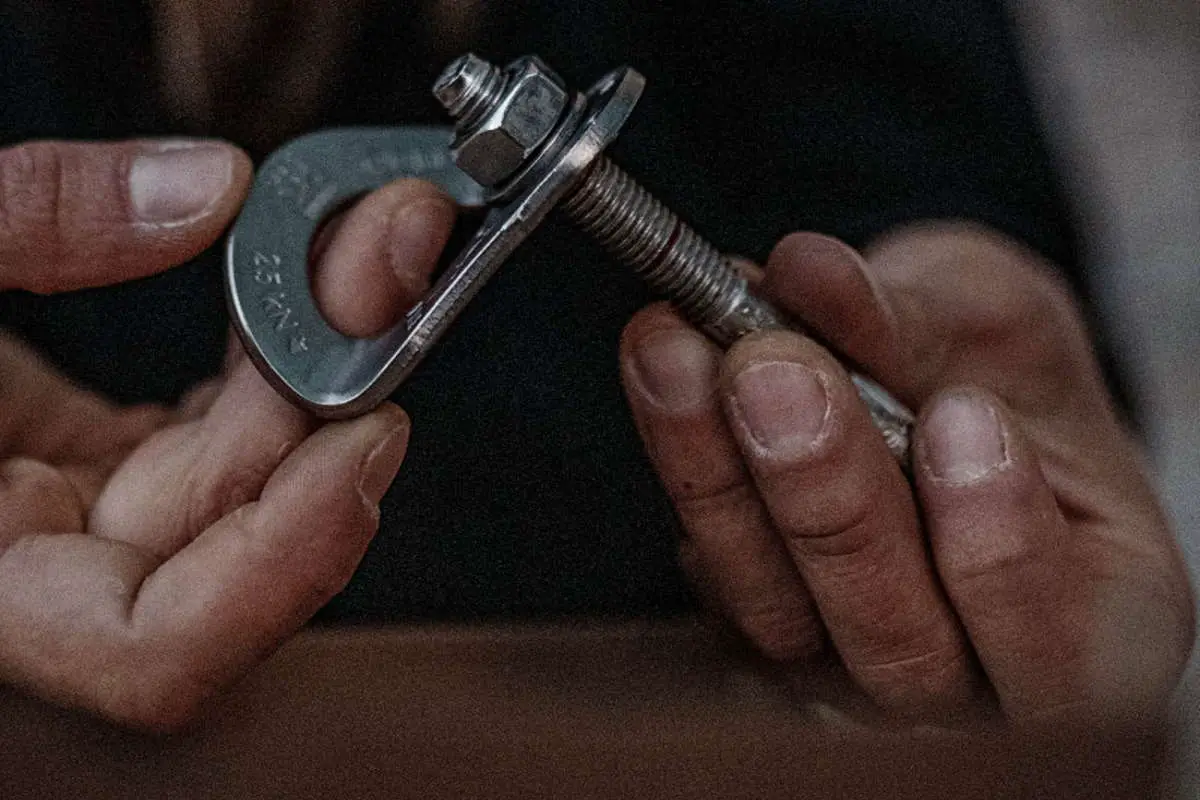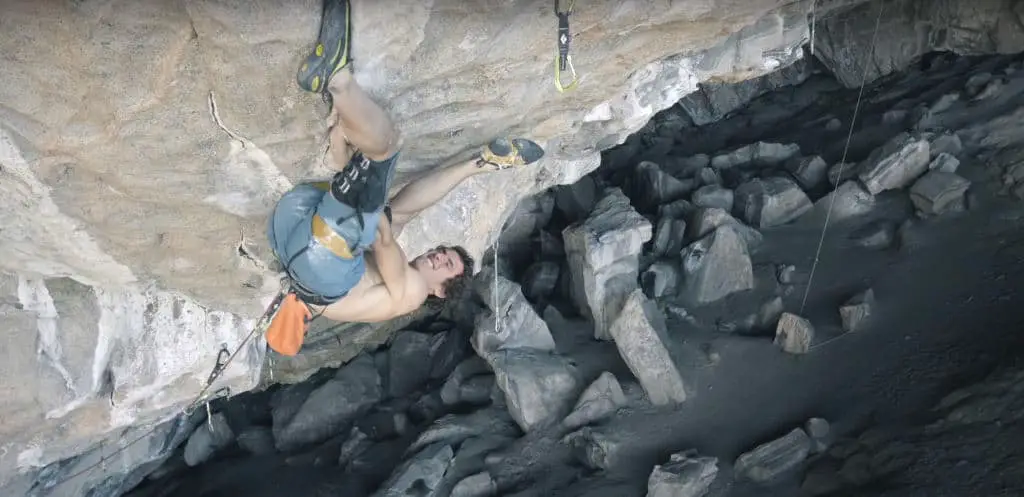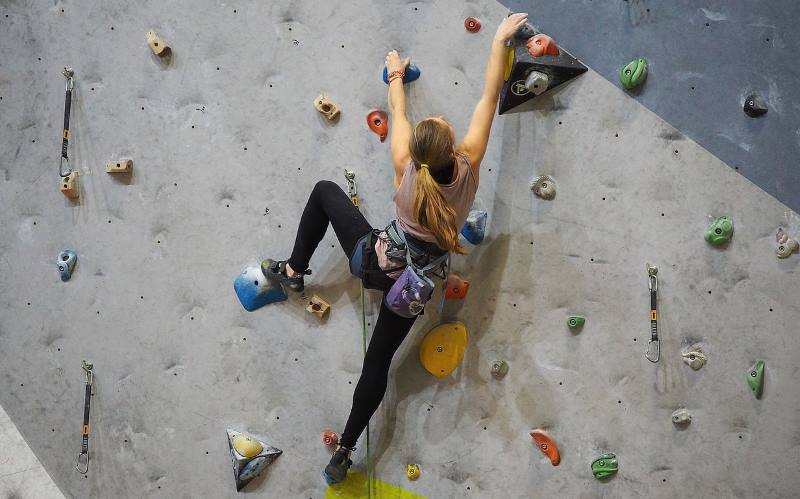The benefits of rock climbing are more varied than just being an interesting workout. The mental game and social side can reap huge rewards too. Embrace your adventurous side and see why we recommend everyone gives climbing a try!
Benefits Of Rock Climbing
Climbing is way more than just a fun thing to try. Done regularly it has huge health benefits. From increasing strength and building muscle, to a more engaging form of cardio, and a great way to practice stretching and flexibility.
Many find indoor rock climbing and bouldering has a huge positive impact on their mental health. The benefits come from the way challenges need to be approached and moves broken down like a puzzle.
The social benefits of climbing make the sport so much more fun. Getting to hang out and talk nonsense with like minded people is a great mid-week release. It can also lead to meeting people up for other adventures outdoors or a great excuse to travel through climbing.
Is Rock Climbing Hard?
Climbing and bouldering are hard in a good way. Indoors and outdoors you’ll find a range of levels to challenge yourself. As you get better there’s always something more to learn, a new trick, or a physical barrier to push through.
Roped Climbing = Attached to a rope that a partner holds with a safety device. Climbing up to 15-20 meters / 49-65 ft depending on where you are. Falls are safe and much less scary than you think. You’ll start with top-roping.
Bouldering = Climbing only to around 4-4.5 meters / 13-14.5 ft. You climb back down or fall/jump onto really thick protective matting that covers the entire area. No ropes or harness needed.
In terms of how hard it is to start or learn to climb – it’s easier than ever. Contact your local climbing gym and book an introduction to bouldering or rock climbing. All the equipment is there to hire at a reasonable price and there are qualified instructors.
A quick session of bouldering gives you all the info you need. For roped climbing you’ll probably want to try a taster session, then ask about introduction courses that take two or three sessions. Climbing gyms are generally really inclusive and welcoming places. Give it a go!
Rock Climbing Health Benefits
Upper Body + Back
Most of the strength involved in climbing comes from a strong upper body and core. Your back muscles especially are worked with the constant pulling motions. You’ll find that the strength gained will help you out in most physical activity plus contribute to a healthy posture.
Core Strength + Abs
Your core muscles are the ones that help support your spine. In climbing those core muscles do a key job of keeping the trunk of the body stable while our limbs move independently. It creates a very strong core which is most noticeable in the six pack ab muscles of many climbers.
Loss of strength in the core as we age can lead to back pain, instability, and loss of overall health. Climbing is excellent for keeping yourself healthy because of the support a strong core gives to the back.
Grip & Forearm Strength
The forearms are probably the first thing you’ll notice in most climbers. Grip is so important to climbing and something that gets stronger and stronger over time. The ability to grip tiny holds and pull your body weight up on them takes time as well as technique.
You’ll find that your forearms will naturally start to become more defined and toned as you climb. You don’t need to do any additional training with grip strengtheners when you start. Rest is more important for your tendons in the first year.
Flexibility, Balance + Coordination
Anyone with a background in dance or yoga will have a big advantage on their first day on the wall. The ability to stretch, contort into odd positions, and to get your legs high and wide is super important to climbing.
Hip flexibility is the number one problem for most getting into the sport. You’ll also find your balance improving as you tip-toe onto micro-holds and learn about smearing.

Cardio
Weirdly climbing is a very cardio intensive exercise. For the small amount of movement, it’s requires a huge amount of breathing and blood pumping. All of your muscles – plus your brain – need a lot of oxygen to stay on the wall and execute hard moves.
The co-ordination needed to work a route means breathing control will play a big part of your success. It’s surprising how out of breath you will get even on a 13 foot boulder. Rock climbing for weight loss can be fairly effective a well as fun.
As a result climbing is a very good cardio workout. You can even focus a whole session around cardio by climbing up and down routes multiple times without coming off. You can also choose “sets” of boulders to repeat without rest.
Read More
– Is Rock Climbing A Good Workout? Rock Climbing For Exercise
– What To Wear Indoor Bouldering + Rock Climbing
– Best Beginner Climbing Shoes / Best Beginner Climbing Rope
Roped Climbing Is A Low Impact Exercise
Surprisingly to some roped climbing can be a very low impact exercise. Top-roping especially means you shouldn’t ever hit the floor, land on your feet, or swing into the wall. Lead climbing can be still be done very safely with a good belay partner.
When you are top-roping there is always a rope above you. You might take a very short fall of a foot or two as the rope stretches – but it’s a nice soft catch. You shouldn’t feel a jerk or pain at all. As a result you can either top-rope with a buddy or use auto-belays for a great low impact workout.
Is Bouldering Low Impact Too?
Unfortunately bouldering can be quite high impact. Because of the falling and jumping you can end up putting a lot of force into your knees and high quite regularly. This can be minimized by down-climbing and avoiding moves where you could take a large fall.
Bouldering mats are thick and designed to absorb falls as much as possible. However, there will always be some impact. It’s also possible to fall awkwardly and get sprains. If your joints are delicate we’d recommend roped climbing instead.
Mental Health Benefits Of Rock Climbing
Personally we think rock climbing benefits mental health more than physical. We all know we’re supposed to exercise three times a week. Really though a lot of the things we tend to to for that exercise feel more like chores than something to be enjoyed.
Climbing gives us an exercise that is engaging, challenging, gives both a strength and cardio workout, and gives us personal choice in managing risk. The social aspects involved and that generally really supportive community add up to a very healthy sport.
Being physically healthy helps cognitive ability and mental health. Being mentally healthy improves our physical ability. Having a physical activity that you look forward to instead of dread makes it much easier to actually go – which is the big problem for many of us.
Engage Or Fall
If you aren’t concentrating, you are going to fall. Rarely in life do we actually have to engage our brains fully to make sure our bodies are doing all the right things at the right times. In climbing you need to coordinate every limb, make sure your balance is perfect, and plan ahead.
That mental engagement means you are really focused on just the one thing. That feeling of being right there in the now is often likened to a physical meditation. Being mindful and present are common modern ways to help mental health – and ones that built in to climbing.
Problem Solving – The Physical Puzzle
The phrase you’ll hear early on is that climbing is like solving a puzzle with your body. It’s cliché but true! You have to think ahead of time, adapt on the wall, and push yourself to make a move even if you think you’ll fall.
The challenges of climbing are unlimited. The variety not just in difficulty, but the types and degrees of walls, different holds, and body positions are almost infinite. It also doesn’t get easier as you improve, the routes just get harder.
Engaging your brain in this way is excellent for cognitive malleability, simply put – keeping sharp. Challenging yourself is fun and pays dividends later on in life. This way you don’t have to sit on a treadmill with a crossword.
Bouldering Is Good For Treating Mental Health Issues
There are multiple studies that back this up. One finds even climbing a tree and practicing balance improve cognitive skills. Another finds bouldering as effective in helping to treat depression and another found bouldering more effective than just home-based physical exercise.
Social Benefits Of Rock Climbing
You could probably turn up for a bouldering session, strap on your shoes, get a coffee, chalk up, and spend two hours sat on the mats without anyone blinking an eye. Sitting around and staring at a route while sharing advice on how to solve it (called beta) might as well be it’s own sport.
Climbers and boulderers love to talk about routes, share their solutions, and chat friendly nonsense as an excuse to actively rest. As a group we’re all fairly friendly and welcoming. If you smile and say hi you’ll get to know regular fairly quickly.

Climbing Community
There are also plenty of social groups there to keep your skills and banter up to date. Contact a group, join the local facebook climbing in *your area here* page, or just ask the closest person what they though of the route they just came down from to make new climbing buddies.
Check out this list of resources and groups that are helping to include everyone in climbing
Travel + Adventure
Rock climbing exists basically everywhere in the world. From the forests outside Paris, to the jungles of South America, to the deserts and ranges of America, and even on that weird piece of climbable “art” in your hometown.
There are well loved climbing destinations with hostels, hotels, and social activities everywhere. There are also less explored destinations to find yourself. There’s also the local secret crag you won’t find in the guidebook.
Climbing as an excuse to travel is an excellent way of having an active holiday that’s more exploration than beach drinking. Not that sandy beaches and blue oceans can’t be involved…
Emotional Benefits Of Rock Climbing
There are two key elements of rock climbing that are hugely beneficial to emotional development and resilience. They are the management of risk, and failure. To climb you must accept the risks involved and that you will, not might, fail.
Risk Management + Personal Choice
To paraphrase the BMC participation statement most climbing instructors in the UK will have memorized and recited daily: “climbing (comes) with a danger of personal injury or death. Participants in these activities should be aware of and accept these risks and be responsible for their own actions.“
While there are varying levels of danger – with indoors climbing and bouldering being regarded as generally very safe – there is always an element. Injuries like a sprained ankle or wrist, and cuts, scuffs, and bruises are common. As you venture outdoors things jump up a notch.
The key thing is that it’s you that makes your own decision on where your level of acceptable risk lies. As you become more comfortable with certain moves, heights, and falls – you’ll become more confident. The same goes for the gear you use, the rock you climb, and the objective hazards around you.
The big thing is that you make that choice. In almost no other sport do you get to make serious choices and accept their possibilities. It’s an important responsibility that you can then apply to every day situations.
Suddenly little things that might have caused you anxiety become easier to deal with. You now have a skill set to use and an actually dangerous activity to judge things against. Risk management in climbing is a hugely rewarding skill for many.

Failure
You will fall. You will fall often. You will at some point feel embarrassed because you fell on a problem you consider “easy”. You will take a weird awkward face-plant in front of the cool group. How you deal with these “failures” gives a lot of room for personal growth.
Failure comes in many forms in climbing and bouldering. The standard is that you climb better and better every session, jumping up the grades. At some point a certain grade becomes the level you deem you should be able to climb.
You then fail miserably on another route of that grade, then fail again, then fail lower. Grading is subjective so no two routes are exactly the same. The main problem though is how we set our standards and how much we accept not hitting them.
Being able to accept you will fail is really beneficial in managing your emotions and personal expectations. Accepting failure and embracing the suck lets you carry on enjoying climbing as just climbing.
Benefits Of Rock Climbing For Children
All of the same benefits here apply to children. Some of the extra benefits of rock climbing that the younger generation get are similar to other sports. Aspects like working with a group, setting personal challenges, and learning to be around others.
Some things specific to climbing involve the emotional resilience of dealing with failure, an early introduction to managing risk, and pushing comfort zones. This may seem like a lot but in children’s climbing groups it starts slowly with simple fun climbs and games, allowing them to be introduced slowly.
As they progress the climbing can become more structured and goal oriented. Climbing competitions are very popular with children with sport climbing now in the Olympics.
Climbing can and should mean more than just competition for children. It’s a life skill that they can enjoy as they grow and can form the basis of a healthy friend group. Travel and work often lead from it and can be hugely rewarding.
Risks Of Rock Climbing
Rock climbing benefits are many and varied but the risks are there. If you are worried about how dangerous climbing looks – be assured that it generally way safer that anyone would first think.
We’d advise you contact a local rock climbing or bouldering gym and ask about the courses they offer. Usually your first taster session is just about climbing as much as possible. The instructor does all the safety stuff so you don’t have to worry. Listen to them.
The most common risks of indoor climbing are bruises, scrapes, cuts, and sore fingers. Common injuries from bouldering are sprained wrists, ankles, or a twisted knee. If you start with an instructor and go at a comfortable pace these are less likely.
Still though you can get injured in different ways. Accidents caused by gear failure are almost nil. Ropes essentially do not break unless in extreme circumstances and generally only outdoors (because of sharp rocks/rockfall/very old rope).
If you do want to venture outdoors do it with a fully certified instructor or guide. We’d advise trying climbing indoors to build up a base level of skill first. You can then learn rope and gear skills indoors and take an “intro to outdoors climbing” style course with the same people.



